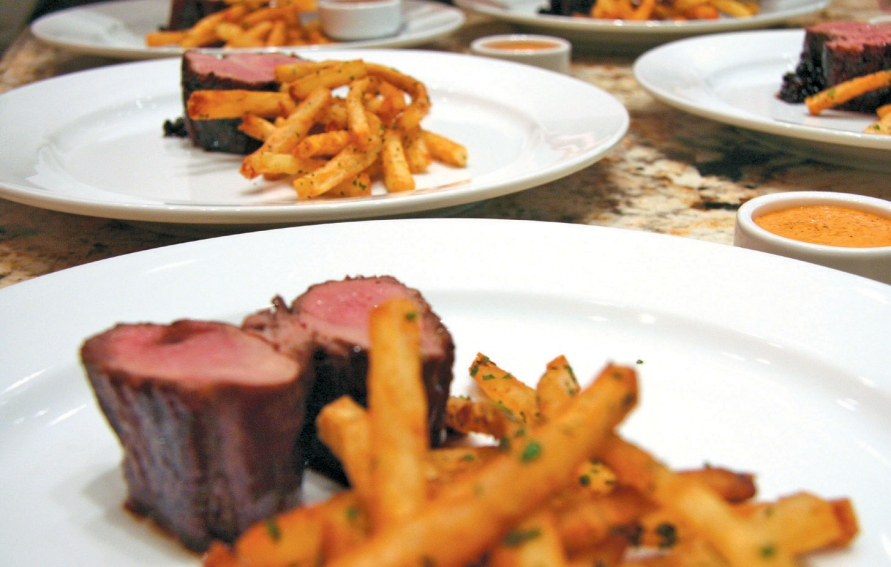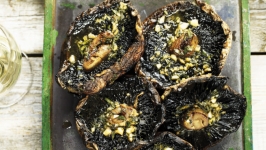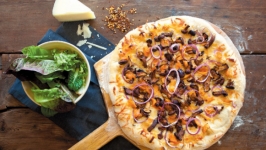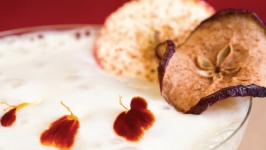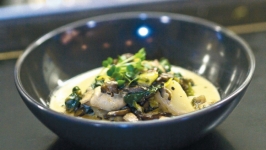Ingredients
- 1/2 cup saba
- 1 1⁄2 teaspoons prepared Dijon mustard
- 2 sprigs fresh thyme
- 2 fresh sage leaves
- Salt and freshly ground black pepper, to taste
- 2 whole duck breasts, lobes separated, skin on (I source my duck from Sonoma’s Liberty Ducks, LibertyDucks.com)
Instructions
Preheat oven to 325°. Prepare the glaze by whisking the saba and mustard together in a saucepot. Add the thyme sprigs and sage leaves and heat gently over a medium-low burner for 2 minutes, then set the pan aside to cool.
Prepare the duck breasts by scoring the fat with a knife in a diamond pattern, being careful not to fully penetrate through the fat to the meat below. Place a wire rack over a shallow pan for roasting, and set it aside.
Preheat a large, heavy skillet (cast iron is ideal) over a medium burner. When the pan is very hot, season the duck well on both sides with salt and pepper, and arrange fat-side-down in the dry pan. Cook for 5 minutes, or until the fat is crisp and brown, then turn on the flesh-side and cook 2 minutes more, or until it is lightly browned.
Remove the duck to the wire rack and allow it to cool for at least 3 minutes.
Use a brush to spread the glaze on both sides of the duck breasts, then place in the oven and roast until 130° internal tempera- ture for rare, or 135° internal temperature for medium (pink center). Allow the duck to rest on the rack in a warm place for 5 minutes before serving. You can dilute any remaining glaze with a few tablespoons of water to serve under or over the duck.
About this recipe
Wine Pairing Suggestion: For Sonoma duck, kissed with sweet glaze, most folks reach for a Sonoma Coast Pinot Noir, with moderate alcohol, oak and tannins and medium to medium-high acidity to contrast against both the fat and sweetness. Don’t get me wrong, it’s been done as much as it has for good reason, but I suggest a path that hasn’t been trodden into a rut. The same region gives us cool-climate Syrahs that can love ducks as well as they love lamb. Arnot- Roberts and Peay are good names to know, but for this dish, Wind Gap Sonoma Coast Syrah is the thing. With refined tannins, a beautiful melding of minerality, lightly cooked dark fruit, hints of earthy olive and spice, this moderately priced gem is a perfect partner. On the duck side of the equation, saba’s sweetness, which might otherwise steal the fruit from such a wine, is tempered by acidity and piquancy in the Dijon, and bal- anced by the fatty, earthy duck. Go all-in with herbed frites fried in duck fat—your efforts will be amply rewarded.
Resource Note: Some wineries have begun to play around with saba production, so ask for it around the Wine country. Terrasonoma, located in Geyserville, is the first commercial producer of saba in the United States. They age their product in bourbon barrels, and the result is worth your notice. Terrasonoma also produces grape verjus, a centuries-old non-vinegar souring agent made from under-ripe fruit, in this case wine grapes.
Verjus is a staple in our kitchen, as it adds acidity without the acetic acid of wine vinegar, which can kill a fine bottle of wine deader than dead. Acetic acid, sometimes called volatile acidity or “VA” (a vinegary smell and taste), can also develop in wine due to bacterial growth and is considered a serious fault with good cause. It stands to reason that eating foods with acetic acid in them before a sip of wine will produce the same lousy taste. Enter verjus.

